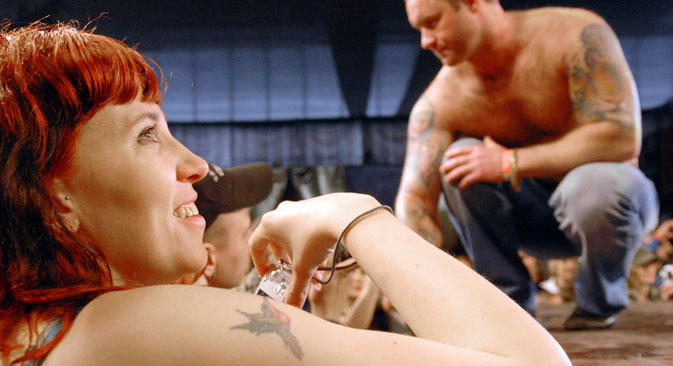
What tattoos are Russians getting rid of? Source: PhotoXPress
The Russian tattoo fad took off 12 years ago with the opening of three major tattoo parlors in Moscow and a training course requiring graduates to complete only two weeks.
Certificates of tattoo master were issued easily, and artists could pick up a suitcase with a ”tattoo machine” and other accessories at any market. Gradually, more and more homegrown parlors opened and proved to be extremely popular.
Today, Russia has Konstantin Avramenko, a laser optician who has patented a gentle way of removing tattoos and scars in Russia, Ukraine and Canada.
His apparatus is a cold-plasma coagulator, which removes the image using electrostatic discharges, which do not penetrate deep into the tissue. His job, he said, is to remove what was done over the course of more than a decade of tattooing.
“I am picking up the pieces of that time,” Avramenko told Moskovskiy Komsomolets.
Avramenko said today the percentage of people removing tattoos over the years has grown considerably. Twenty people in every hundred want to get rid of their “mistakes of past.”
Sometimes people are ashamed to show tattoo art and try to remove a pattern or inscription at home, and sometimes will using a drilling machine, he said.
Or, equally as bad, they apply potassium permanganate to the area with a tattoo, which corrodes skin to sores in a matter of hours. The area where the tattoo was removed is then washed with water, and people wait for the sore to heal.
Other dangerous removal methods have also been invented: Prisoners invented a tattooing machine with a solution of milk and streptocide, which sometimes pieced the skin.
Milk lightens the tattoo’s ink, but in two to three days the affected skin where the image was begins to decay, and scarring begins a month after the decaying process is complete, Avramenko said.
Even household soap has been used for removing tattoos. “The soap is melted and dripped onto the area of skin with the tattoo. Soap contains a higher percentage of alkali so, in addition to a regular burn, a serious chemical burn appears in two to three days. Then the person removes the burnt area and waits for the sore to scar over,” Avramenko explained.
Though a laser process is safer, Avramenko cautioned that it cannot remove a tattoo image either; it can only make it lighter.
“I once worked as a laser technician at a research institute. We developed a device there that would stop the blood in the case of terrible injuries. Once I tried to remove a tattoo from a friend using this device. It worked! The method is simple: a 2 mm to 3 mm (0.07 inch to 0.12 inch) hole is burned onto the tattoo area. Paint with dye turns to smoke and disappears. The wound is treated with alcohol, and I guarantee a new layer of skin in the same place within six months,” the specialist explains. The most difficult thing is to remove the pictures in the form of rings on fingers.
“Signet rings are usually tattooed in prison. The people are released and branded with such a past, they find it impossible to find a job,” Avramenko said. “I take $400 to remove a signet ring. People pay without thinking twice; they simply have nowhere to go.”
The laser optician said he has heard so many stories about unwanted tattoos that he even wants to write a book on the subject.
“Girls remove little roses on their chests, patterns on the small of their back, flowers and butterflies on the shoulders. Young people ‘burn out’old-fashioned wolves and tigers,” he said, adding that young couples often come to him who once tattooed each other's names on each other’s wrists.
Once he was visited by a former paratrooper with complex tattoos: airplanes, wings, parachute and death with a scythe. He begged Avramenko to remove this picture for any money, saying he was sure that it brought him bad luck. There are customers with the “666” tattoo.
“One day, some parents asked me to remove their 15-year-old son’s tattoo that read ‘Live quickly die young,’ while he was in a coma,” he said. “A girl came to me with a tattoo on her right buttock, which read ‘Property of Misha.’ Another lady requested that I remove the tattooed word ‘Arthur’ from her belly.”
The master has also removed images of butterflies, dolphins and panthers from the bodies of his patients.
“Everyone wants to remove dolphins. The owner of this tattoo is considered to be a loser. In addition, there is a prison in Russia where prisoners serve life terms, which is called a ‘Dolphin.’
It is the same with a butterfly: there is a conviction in the human mind that a butterfly symbolizes a a loose woman. These things are programmed into the subconscious,” he said.
He warns against the use of hieroglyphs on the body, because he remembers a case when, instead of a Chinese symbol for prosperity, a body was marked with the Korean hieroglyph for demon.
“One day I was visited by an old man of about 70 years,with a strange request: to remove a rather frivolous inscription on his manhood. I was surprised and asked him ‘Why? Nobody is likely to see it, are they?’ The elderly man was confused: ’But we are nudists! I am ashamed of the tattoo in front of my grandson on the beach,’” Avramenko said.
First publishd in Russian in Moskovsky Komsomolets.
All rights reserved by Rossiyskaya Gazeta.
Subscribe
to our newsletter!
Get the week's best stories straight to your inbox